
English cuisine encompasses the cooking styles, traditions and recipes associated with England. It has distinctive attributes of its own, but is also very similar to wider British cuisine, partly historically and partly due to the import of ingredients and ideas from the Americas, China, and India during the time of the British Empire and as a result of post-war immigration.

A pancake, also known as hotcake, griddlecake, or flapjack, is a flat cake, often thin and round, prepared from a starch-based batter that may contain eggs, milk, and butter, and then cooked on a hot surface such as a griddle or frying pan. It is a type of batter bread. Archaeological evidence suggests that pancakes were probably eaten in prehistoric societies.

A scone is a traditional British baked good, popular in the United Kingdom and Ireland. It is usually made of either wheat flour or oatmeal, with baking powder as a leavening agent, and baked on sheet pans. A scone is often slightly sweetened and occasionally glazed with egg wash. The scone is a basic component of the cream tea. It differs from teacakes and other types of sweets that are made with yeast. Scones were chosen as the Republic of Ireland representative for Café Europe during the Austrian presidency of the European Union in 2006, while the United Kingdom chose shortbread.

Clotted cream is a thick cream made by heating full-cream cow's milk using steam or a water bath and then leaving it in shallow pans to cool slowly. During this time, the cream content rises to the surface and forms "clots" or "clouts", hence the name. Clotted cream is an essential ingredient for cream tea.

A tea sandwich is a small prepared sandwich meant to be eaten at afternoon teatime to stave off hunger until the main meal.
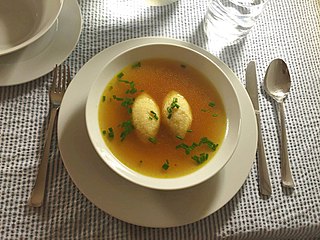
Austrian cuisine consists of many different local or regional cuisines. In addition to Viennese cuisine, which is predominantly based on the cooking traditions of the Habsburg Empire, there are independent regional traditions in all the states of Austria.

Fruit curd is a dessert spread and topping. It is usually made with citrus fruit, though may be made with other fruits. Curds are often used as spreads and as flavourings.

Kaymak, sarshir, or qashta/ashta, is a creamy dairy food similar to clotted cream, made from the milk of water buffalo, cows, sheep, or goats in Central Asia, some Balkan countries, some Caucasus countries, the countries of the Levant, Turkic regions, Iran and Iraq.
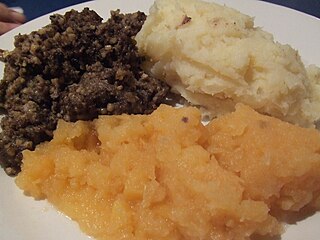
Scottish cuisine encompasses the cooking styles, traditions and recipes associated with Scotland. It has distinctive attributes and recipes of its own, but also shares much with other British and wider European cuisine as a result of local, regional, and continental influences — both ancient and modern.
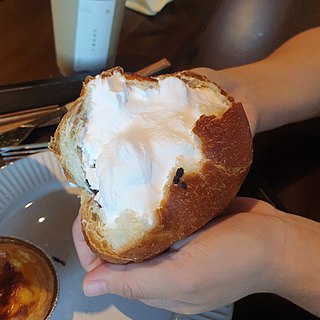
Variations of cream buns or cream rolls exist all around the world. Typically they are made with an enriched dough bread roll that is split after baking and cooling and filled with cream.

Tea is an umbrella term for several different meals consisting of food accompanied by tea to drink. The English writer Isabella Beeton, whose books on home economics were widely read in the 19th century, describes meals of various kinds and provides menus for the "old-fashioned tea", the "at-home tea", the "family tea", and the "high tea".

A banana split is an American ice cream-based dessert consisting of a peeled banana cut in half lengthwise, and served with ice-cream and sauce between the two pieces. There are many variations, but the classic banana split is made with three scoops of ice cream. A sauce or sauces are drizzled onto the ice cream, which is topped with whipped cream and maraschino cherries. Crushed nuts are optional.
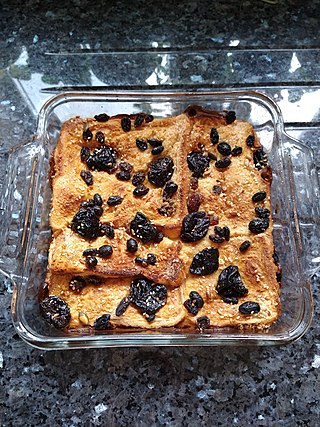
Bread and butter pudding is a traditional bread pudding in British cuisine. Slices of buttered bread scattered with raisins are layered in an oven dish, covered with an egg custard mixture seasoned with nutmeg, vanilla, cinnamon or other spices, then baked.

Cornish cuisine encompasses the cooking styles, traditions and recipes associated with Cornwall and the Cornish people. It has been heavily influenced by the geography of the county as well as its social history.

Sponge cake is a light cake made with eggs, flour and sugar, sometimes leavened with baking powder. Some sponge cakes do not contain egg yolks, like angel food cake, but most of them do. Sponge cakes, leavened with beaten eggs, originated during the Renaissance, possibly in Spain. The sponge cake is thought to be one of the first non-yeasted cakes, and the earliest attested sponge cake recipe in English is found in a book by the English poet Gervase Markham, The English Huswife, Containing the Inward and Outward Virtues Which Ought to Be in a Complete Woman (1615). Still, the cake was much more like a cracker: thin and crispy. Sponge cakes became the cake recognised today when bakers started using beaten eggs as a rising agent in the mid-18th century. The Victorian creation of baking powder by English food manufacturer Alfred Bird in 1843 allowed the addition of butter to the traditional sponge recipe, resulting in the creation of the Victoria sponge. Cakes are available in many flavours and have many recipes as well. Sponge cakes have become snack cakes via the Twinkie.
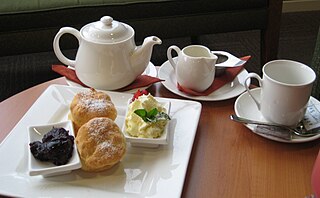
The cuisine of Devon in England has influenced, and been influenced, by other British cuisine. Its tradition of dairy farming has resulted in several dishes, some of which have made both it and Cornwall famous, such as cream teas and junket. Because Devon is largely a rural county, it likewise has a strong reputation for excellent pasture-raised beef and lamb. Orchard fruits are also important, particularly apples, used both for cider as well as for apple-based desserts. The long coastline supplies the county with a wide variety of fish and seafood.

English afternoon tea is a British tradition that involves enjoying a light meal of tea, sandwiches, scones, and cakes in the mid-afternoon, typically between 3:30 and 5 pm. It originated in the 1840s as a way for the upper class to bridge the gap between lunch and a late dinner.
Breakfast, the first meal of the day eaten after waking from the night's sleep, varies in composition and tradition across the world.




















